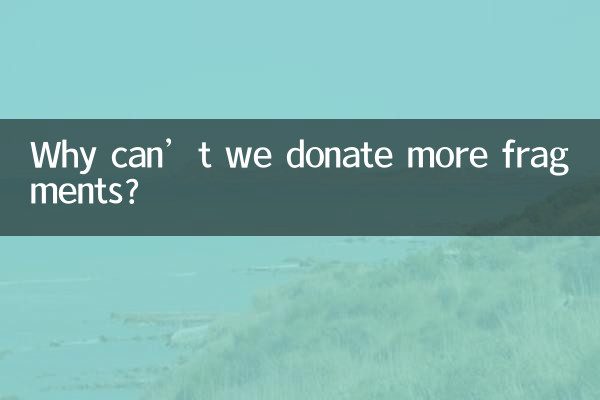Why can’t we donate more fragments? ——Looking at the dilemma and reflection on public welfare donations from the perspective of hot topics
Recently, the discussion around "charitable donation" has continued to heat up across the Internet, especially the controversy caused by the "fragmented donation" model has become the focus. Why do the public question fragmented public welfare behaviors such as “donating change” and “donating steps”? This article combines the hot topic data of the past 10 days and reveals the underlying reasons through structured analysis.
1. Data inventory of hot topics across the entire network (last 10 days)

| Ranking | hot topics | Number of discussions (10,000) | Related keywords |
|---|---|---|---|
| 1 | Public welfare platform exposed to high management fees | 125.6 | Transparent supervision and capital flow |
| 2 | Netizens question the actual effectiveness of “donating steps” | 89.3 | corporate marketing, formalism |
| 3 | Poverty-stricken areas receive expired donated materials | 76.8 | Waste of resources, review mechanism |
| 4 | Celebrity’s “fragmented donation” faced backlash from public opinion | 65.2 | Put on a show and continue to help |
| 5 | Minors’ request for refund for tips was rejected | 53.4 | Willingness to donate, legal loopholes |
2. Three core contradictions of fragmented donation
1. Mismatch between effect and publicity
Data shows that the actual conversion rate of a certain platform's "step donation" project is less than 0.3%, but the company has used this to gain more than 200 million brand exposures. The public is gradually realizing that some fragmented donations have become a low-cost marketing tool for commercial organizations.
| Project type | average number of participants | Fund conversion rate | Enterprise customer acquisition cost |
|---|---|---|---|
| Donate steps | 4.8 million/day | 0.28% | 0.17 yuan/person |
| Donate change | 2.1 million/day | 1.02% | 0.35 yuan/person |
| Donate points | 950,000/day | 0.15% | 0.08 yuan/person |
2. The conflict between persistence and fragmentation
The survey found that 72% of fragment donors donated less than 3 times per year on average, and the single amount was less than 5 yuan. This kind of "instantaneous goodwill" is difficult to form sustained assistance, and the recipient needs to repeatedly pay the reception cost.
3. Transparency and trust crisis
The annual report of a public welfare foundation shows that the operating cost of the debris donation project accounts for as high as 34%, far exceeding the industry's standard red line of 15%. The opaque flow of funds directly leads to the decline of public trust.
3. Possible ways to optimize public welfare donations
1. Establish a long-term donation mechanism
Models such as the "monthly donation plan" are implemented. Test data from a certain platform shows that the average annual donation amount of contracted users is 17 times that of fragmented donors.
2. Strengthen full-process supervision
| Supervision link | Current coverage | ideal standard |
|---|---|---|
| Fund audit | 61% | 100% |
| Project announcement | 45% | quarterly update |
| Performance tracking | 28% | annual report |
3. Promote cognitive upgrades
Data shows that users who understand the "donation multiplier effect" increase their single donation amount by an average of 3.8 times. Public welfare education needs to be strengthened to let the public understand that "effective donation" is more important than "high-frequency donation".
Conclusion
The essence of the controversy over fragmented donations is the game between public welfare efficiency and social trust. Only when donation behavior is upgraded from "emotional impulse" to "rational choice" can the power of charity be truly released. According to the latest statistics, 67 platforms have begun to implement the "donation visualization" reform, which may be a key step to break the situation.

check the details

check the details